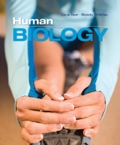
EBK HUMAN BIOLOGY
11th Edition
ISBN: 8220100545931
Author: MCMILLAN
Publisher: Cengage Learning US
expand_more
expand_more
format_list_bulleted
Textbook Question
Chapter 7, Problem 4CT
Several years ago the deaths of several airline travelers led to warnings about “economy-class syndrome.” The idea is that economy-class passengers don’t have as much leg room as passengers in more expensive seats, so they are more likely to sit essentially motionless for long periods on flights—conditions that may allow blood to pool and clots to form in the legs. This condition is called deep-vein thrombosis, or DVT. Given what you know about blood flow in the veins, explain why periodically getting up and moving around in the plane’s cabin during a long flight may lower the risk that a clot will form.
Expert Solution & Answer
Trending nowThis is a popular solution!

Students have asked these similar questions
Several years ago, the deaths of several airline travelers led to the warning about “economic-class syndrome.” The idea is that economic-class passengers do not have as much leg room as passengers in more expensive seats, so they are more likely to sit essentially motionless for long periods of flights-conditions that may allow blood to pool and clots to form in the legs. This condition is called deep-vein thrombosis, or DVT. Given what you know about blood flow in the veins, explain why periodically getting up and moving around in a plane’s cabin during a long flight may lower the risk that a cloth will form.
The exact cause of blood clotting in the left atrium of the heart during atrial fibrillation (AF) is not known. In part it might be due to blood stasis (not moving) or it may result in combination with endothelial cells damage.
(A) What are the potential mechanisms that might drive clotting and what markers might you look for in the blood to predict potential risk?
(B) Other than treating the arrhythmia, what other pharmacological intervention might be provided to AF sufferers?
Let’s say an arteriole dilates to 50% greater than its original size (i.e., the new radius of the arteriole is 1.5 times the original radius). How does the blood flow rate through the arteriole change after dilation? (Hint: You do not need to know the exact values for viscosity, arteriole length, or pressure gradient in order to answer this question.)
Chapter 7 Solutions
EBK HUMAN BIOLOGY
Ch. 7 - List the functions of the cardiovascular system.Ch. 7 - Define a heartbeat, giving the sequence of events...Ch. 7 - What is the difference between the systemic and...Ch. 7 - Prob. 4RQCh. 7 - Prob. 5RQCh. 7 - State the main functions of venules and veins....Ch. 7 - Label the hearts main parts in the diagram below.Ch. 7 - Cells obtain nutrients from and deposit waste into...Ch. 7 - The contraction phase of the heartbeat is ______;...Ch. 7 - Prob. 3SQ
Ch. 7 - In the systemic circuit, the hearts _______ half...Ch. 7 - After you eat, blood passing through the GI tract...Ch. 7 - Prob. 6SQCh. 7 - Prob. 7SQCh. 7 - Prob. 8SQCh. 7 - _____ contraction drives blood through the...Ch. 7 - Match the type of blood vessel with its major...Ch. 7 - Prob. 11SQCh. 7 - A patient suffering from hypertension may receive...Ch. 7 - Heavy smokers often develop abnormally high blood...Ch. 7 - Prob. 3CTCh. 7 - Several years ago the deaths of several airline...
Knowledge Booster
Learn more about
Need a deep-dive on the concept behind this application? Look no further. Learn more about this topic, biology and related others by exploring similar questions and additional content below.Similar questions
- The abnormal narrowing of the lumen of a vein is known as _____________________.arrow_forwardThe major change in blood flow would be an increase in certain abdominal organs. Explain with an example?arrow_forwardBoth prothrombin and fibrinogen are normally present in the plasma, yet clotting usually occurs only in the presence of vascular damage. Why?arrow_forward
- You wanted to prepare a fish dish for your grandfather that he loves the dried salted Codfish. But you noticed that this might be causing a problem for your elder grandfather since he has hypertension, what would you do to remove the salt from the fish? (Answer with one word) What is the mechanism by which the salt gets out from the fish? (one word) Please put a comma and space between * the two answers word. Answer:arrow_forwardWhat term is used to describe normal, quite blood flow?arrow_forwardName any two substances which prevent blood coagulation in uninjured blood vessels.arrow_forward
arrow_back_ios
arrow_forward_ios
Recommended textbooks for you
 Human Biology (MindTap Course List)BiologyISBN:9781305112100Author:Cecie Starr, Beverly McMillanPublisher:Cengage Learning
Human Biology (MindTap Course List)BiologyISBN:9781305112100Author:Cecie Starr, Beverly McMillanPublisher:Cengage Learning Human Physiology: From Cells to Systems (MindTap ...BiologyISBN:9781285866932Author:Lauralee SherwoodPublisher:Cengage Learning
Human Physiology: From Cells to Systems (MindTap ...BiologyISBN:9781285866932Author:Lauralee SherwoodPublisher:Cengage Learning Comprehensive Medical Assisting: Administrative a...NursingISBN:9781305964792Author:Wilburta Q. Lindh, Carol D. Tamparo, Barbara M. Dahl, Julie Morris, Cindy CorreaPublisher:Cengage Learning
Comprehensive Medical Assisting: Administrative a...NursingISBN:9781305964792Author:Wilburta Q. Lindh, Carol D. Tamparo, Barbara M. Dahl, Julie Morris, Cindy CorreaPublisher:Cengage Learning Medical Terminology for Health Professions, Spira...Health & NutritionISBN:9781305634350Author:Ann Ehrlich, Carol L. Schroeder, Laura Ehrlich, Katrina A. SchroederPublisher:Cengage Learning
Medical Terminology for Health Professions, Spira...Health & NutritionISBN:9781305634350Author:Ann Ehrlich, Carol L. Schroeder, Laura Ehrlich, Katrina A. SchroederPublisher:Cengage Learning

Human Biology (MindTap Course List)
Biology
ISBN:9781305112100
Author:Cecie Starr, Beverly McMillan
Publisher:Cengage Learning

Human Physiology: From Cells to Systems (MindTap ...
Biology
ISBN:9781285866932
Author:Lauralee Sherwood
Publisher:Cengage Learning

Comprehensive Medical Assisting: Administrative a...
Nursing
ISBN:9781305964792
Author:Wilburta Q. Lindh, Carol D. Tamparo, Barbara M. Dahl, Julie Morris, Cindy Correa
Publisher:Cengage Learning



Medical Terminology for Health Professions, Spira...
Health & Nutrition
ISBN:9781305634350
Author:Ann Ehrlich, Carol L. Schroeder, Laura Ehrlich, Katrina A. Schroeder
Publisher:Cengage Learning
Complications during Labour and Delivery; Author: FirstCry Parenting;https://www.youtube.com/watch?v=QnCviG4GpYg;License: Standard YouTube License, CC-BY